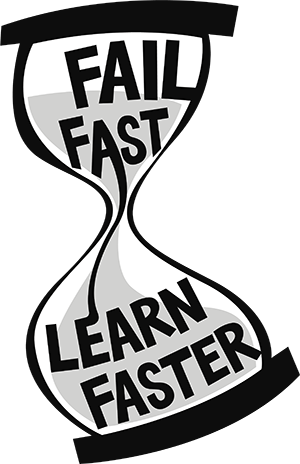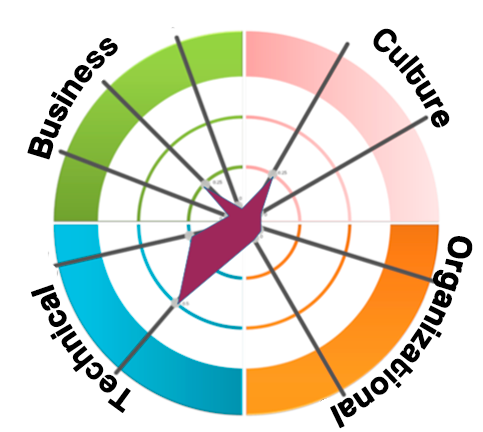A lot is said about Agile Transformation. But do people really know what this means? What is necessary to transform a whole organization by following a new way of thinking?
To start with, it’s important to understand that Agile Transformation is a complete redesign of organizational thinking. It is a major shake-up of the Taylor model in force since the end of the 19th century. Taylor and Fayol started with the principle that if the objective of organizations is to continually grow, a hierarchical structure would be necessary to embody and resolve the problems resulting from this growth. Planning, organization, coordination, command and control were the management’s most important activities, according to Fayol. This model is heavily based on military structures, which in turn were the hierarchical structures available for study. And because of this, nowadays our organizations are heavily based on command and control. Standards! We must have standards. It’s as if we believed this model, initially designed for the factory unit, could be used for everything. Big mistake.
Salt, sugar, coffee and gold have all been signs of wealth in the past. Today, in the 21st century, knowledge is the greatest wealth there is. And knowledge cannot be commanded and controlled. However, knowledge can be amplified and shared, depending on how we use with it.
in order to innovate, there must be knowledge and creativity, and neither grows in soil which is limited, controlled or stuck. Innovation depends on empowerment: doing that which you believe in, with trial and error, until you find the right path.

The world’s most innovative organizations have one very important thing in common: they are followers of Agile culture. They are defenders of self-organization and the empowerment of teams. But how did they manage to get there?
4 domains of agility

The 4 domains of agility help understand what needs to change in an organization so they can embrace the agile mindset and transform themselves into creative, open environments which dare to naturally fail as a way of learning, and which constantly seek collaboration, rather than excessive control and factory standardization.
The business domain deals with how organizations define their objectives. Prioritization, budgeting, business direction and demands of the new products and services all come out of this.
The cultural domain defines how we think and act. The organizational mindset. Want to understand your organization’s mindset? Easy! What happens when someone makes a mistake? Think hard about this. Culture is the result of how we act and think. Even when this takes place automatically. In a lot of places, making mistakes is pretty much a crime and incurs severe punishment.
The organizational domain relates to how the company is structured. The number of organizational levels, departments, etc. Giant structures are like the Titanic: difficult to move quickly. Changing direction is a slow process and often, when it does finally occur, it’s already too late. And don’t forget the iceberg doesn’t even move!
The technical domain speaks to how teams work: norms, quality, technical knowledge. Empowered teams are more creative, responsive and efficient.
The most common organization problems are connected to one or more of these domains. And that’s where Agile transformation comes in.
Agile Transformation must involve the organization as a whole
It’s very important to highlight that there can be no agility if we only focus on one of these domains. Many organizations fail because they leave one of them aside. People often think that for the whole organization to be agile, you just need agile teams.
To this day I don’t understand why people think Agile is something you only apply to development teams. As of only a small part of the organization needed to adapt to new times. In my classes, I always do an exercise where I ask the students to describe the greatest problems they face in their companies. It’s no surprise to see that the domain where the fewest problems arise needing a solution is the technical one. I even joke with the developers present: You see? It’s not your fault!
High-performance teams are small, stable, durable, multi-functional, autonomous and often don’t respect the barriers separating the departments. The way in which companies are structured hinders the creation and maintenance of such teams.
Again, I say: Agile Transformation must involve the organization as a whole. From HR to the board of directors. From the intern to the CEO. And the process of transformation demands not only the participation of all but a change in how we work. It is necessary that we redesign the organizational structure, breaching silos and solving once and for all the evils of over-verticalization.
Gary Hamel, professor at the London Business School and one of the gurus of modern management, states that overly large organizational structures cost the American market alone 3 trillion dollars. In the US, there is a manager for every 4.7 people. Gary claims that it is possible to go from 4.7:1 to 10:1, freeing up 12.5 million managers so they can start producing value directly, instead of inspecting those who do.
Our organizations have become environments which are too complex. Ones in which fulfilling individual goals are valued more than the incentive, in exchange for knowledge and collaboration. We’ve become laboratory mice on treadmills which never stop. Command and control, applied intravenously. Daily reports of hours worked focus on effort and not value generated. We’re cogwheels in a vast machine, which is precisely the subject of Charles Chaplin‘s critique in his sensational 1936 film “Modern Times”.
Agile Organizations favor that which nowadays has the greatest value: knowledge. They are organizations designed to maximize collaborative work, based on experimentation with the objective of generating learning, focusing on business value and always keeping things simple, rather than overrating complex environments. Self-organization and the proximity of teams and people are two of the principles guiding these organizations.
Therefore, transforming an organization means rethinking structures, processes, controls, targets, the physical environment, bonuses and career progress. Everything changes. And changes for the better.
But there are two choices available at the moment: change now and get a competitive advantage, or wait to change later, when it’ll be too late and the company is desperately fighting for survival, because the market has already changed and your company got left behind.
Deep down, the second choice is already the reality for a lot of businesses out there.
Want to know more?
Follow our blog to get the latest news.
